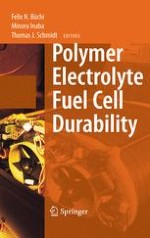
2009 | OriginalPaper | Buchkapitel
Introduction
Erschienen in: Polymer Electrolyte Fuel Cell Durability
Verlag: Springer New York
Aktivieren Sie unsere intelligente Suche, um passende Fachinhalte oder Patente zu finden.
Wählen Sie Textabschnitte aus um mit Künstlicher Intelligenz passenden Patente zu finden. powered by
Markieren Sie Textabschnitte, um KI-gestützt weitere passende Inhalte zu finden. powered by
Durability is one of the most important issues for commercialization of polymer electrolyte fuel cell (PEFC) based automotive and stationary applications, as well as cost and hydrogen storage. The current lifetimes of fuel cell vehicles and stationary cogeneration systems are approximately 1,000 h and approximately 10,000 h (2008), respectively, and should be improved before they are commercialized in the near future. The 2010/1015 US DOE lifetime target for automotive applications is 5,000 h, which is equivalent to 150,000 driven miles, and the Japanese NEDO's lifetime targets for stationary applications are 40,000 and 90,000 h in 2010 and 2015, respectively.
PEFCs consist of a number of different components, such as catalysts, membranes, gas-diffusion layers, bipolar plates, and sealings. To achieve the durability targets for PEFC systems, it is essential that each of the components has the required durability. To close the gap between today's status and the required targets it is important to understand the degradation phenomena of each of the components used in PEFCs and to improve their durability. The comprehensive analysis and understanding of the degradation phenomena of each component in a cell or stack is not easy. This difficulty arises from the fact that the stability of each component greatly depends on a wide variety of operation conditions, such as temperature, cell voltage, and the degree of humidification of the cell or stack. In addition, degradation of one component in a cell often causes parasitic degradation of other components. This therefore requires a detailed separation, analysis, and understanding of the individual degradation processes of the various components. Another issue is the long durability goals, which require the development of accelerated test methods to facilitate the development of highly durable materials. Here again we encounter a great difficulty because elevating temperature, a strategy which is widely employed as an accelerating parameter in many fields, usually changes not only the properties of a material itself, but also correlations with other materials.